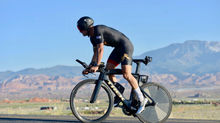Training in Adverse Conditions
- Jason Lentzke
- Jun 3, 2023
- 4 min read
Training for your next Ironman event is going to involve the overcoming of obstacles and enduring several mental and physical peaks and valleys. Never get too high and never get too low. Just keep moving forward, just like you’ll do on race day. Have a plan, embrace the challenges and think constant positive thoughts.

If you’re training for a fall race, there’s a good chance you’re going to be grinding away in some fairly demanding or even tropical conditions. Here are few tips to stay on top of your game and get to the starting line healthy.
Training in the Heat:
If you’re training for a warm-weather event, it’s ideal to train outdoors in the conditions you’ll be facing on race day. This will give your body an opportunity to acclimate before the event and achieve proper sweat rate and blood plasma adaptations.
Additionally, it’s an opportunity to dial in your fueling and hydration strategy to set yourself up for your best race. To race well, you need an established and tested fueling plan. To do this, you need to set a base line sweat rate by performing your own sweat test. Once you have your results, you’ll have your calculated sodium losses and estimate carbohydrate requirements.
Keep in mind that every individual has an upper limit for the amount of carbohydrate they can ingest and absorb per hour. The key is to identify your optimal absorption rate in training so that you are maximizing your performance potential on race day.
You must train your stomach/digestive system to tolerate gels, salt pills, sports drink and bars. Use the results of your sweat test to dial in your fueling strategy at least 3 months prior to race day. Train your gut to tolerate fuel at all intensities to reduce the risk if GI distress on race day.
Lastly, training in the heat is much easier when you’re at an ideal body composition for your gender and age. Excess body fat has a major impact on sweat rate and heat dissipation. Consult with a Board Certified Sports Dietitian to get a better idea on what your ideal body composition for race day may be.

Once an athlete has obtained their accurate body composition data, we use the chart above to determine their optimal short-term body fat percentage goal. However, do not forget that that this specific, "optimal" body fat percentage may not be ideal for a particular athlete and we don't walk around at race weight all year. There are many factors above and beyond the numbers that play into this, and is best assessed with a professional's help.

Dry heat vs Humid Heat:
Dry heat will affect your RPE, HR, and pace similarly to humid conditions, but the higher temperature may affect your nutrition differently. Typically, it’s more challenging for our digestive system to break down solid foods in the extremely high temperatures that dryer desert conditions throw at us, so try to get as many calories as you can in liquid form. Most of your blood is going to your skin to attempt to cool your body and not to your digestive system, so don’t make your body work any harder than it needs to! If your digestive system has a little less work to do, you’ll probably have a much better GI experience.
Extremely humid conditions throw us another curveball. Our bodies cool themselves during the sweat evaporation process. The air is filled with excess water vapor in humid conditions, so your sweat won’t evaporate very efficiently. Why is this an issue? Essentially, it makes sweating a less effective way for your body to attempt to reduce its core temperature in humid conditions.
Whether you’re enduring dry or humid heat, your breathing will be labored, pace and power numbers will decrease and your nutritional demands will increase. Have a sound fueling plan and practice it daily to set yourself up for optimal performance.
Rain:
Warm and cold rain can pop up at any moment in places like the desert or coastal regions. The omnipresence of monsoons during certain times of the year can make every ride a gamble. However, as long as you take a few essential precautions, rain is nothing that needs to end your training session prematurely. Note, always use common sense and if you lack visibility or see lightning pull over immediately to seek shelter.
-Always ride with a high powered rear red light. When the rain picks up you will me much more likely to be seen.
-If you know it’s going to be a steady rain, pull over and tap your presta valve 2-3 times to reduce the air pressure. This will give you a little more traction in wet conditions.
-You need a bit more time to stop and/or turn so be sure to clear debris from your brake tracks/rim by feathering your brakes.
-Avoid road paint (very slick), puddles (you don’t know what’s underneath), sand, oil and gravel. These hazards are extremely slick in wet conditions and it’s very easy to lose traction
-Ride with clear or amber colored lenses to keep your eyes protected and improve optics.
-Lastly, be sure to wipe down, clean and lube your bike after a day in the rain!


























